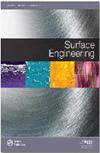全氢聚硅氮烷保护膜的比较研究
IF 2.6
4区 材料科学
Q3 MATERIALS SCIENCE, COATINGS & FILMS
引用次数: 0
摘要
摘要:二氧化硅薄膜是太阳能电池中保护玻璃的一种很有前途的替代品。在本工作中,从二丁基醚溶液中旋涂一层和四层全氢聚硅氮烷(PHPS)薄膜,并通过暴露于中等温度或紫外线(UV)光进行固化,以获得玻璃状SiOx层。使用XPS、FTIR、UV-Vis光谱和SEM显微镜结合EDX分析研究了它们的光学和形态性质及其长期稳定性。结果表明,在两种方法的固化程序完成后,将PHPS层转化为SiOx的过程仍在继续。然而,热固化膜的组成类似于氧化硅,而UV固化样品由于固化过程中发生的反应的差异而表现出类似于二氧化硅的组成。延长的转化过程为创造基于PHPS的自我改进保护涂层开辟了可能性。图形摘要本文章由计算机程序翻译,如有差异,请以英文原文为准。
Comparative study of perhydropolysilazane protective films
ABSTRACT Silicon dioxide thin films are a promising alternative to protective glass in solar cells. In this work, one-layer and four-layer thin films of a perhydropolysilazane (PHPS) were spin-coated from solution in dibutyl ether and cured by exposure to moderate temperatures or ultraviolet (UV) light to obtain glassy SiOx layers. Optical and morphological properties as well as their long-term stability were studied using XPS, FTIR, UV-Vis spectroscopy, and SEM microscopy with EDX analysis. The results showed that the process of converting PHPS layers to SiOx continues after the completion of the curing procedure for both methods. However, the composition of the thermally cured films is similar to silicon oxide, while the UV-cured samples demonstrate a composition similar to silicon dioxide due to differences in the reactions occurring during the curing process. The prolonged transformation process opens up possibilities for creating self-improving protective coatings based on PHPS. GRAPHICAL ABSTRACT
求助全文
通过发布文献求助,成功后即可免费获取论文全文。
去求助
来源期刊

Surface Engineering
工程技术-材料科学:膜
CiteScore
5.60
自引率
14.30%
发文量
51
审稿时长
2.3 months
期刊介绍:
Surface Engineering provides a forum for the publication of refereed material on both the theory and practice of this important enabling technology, embracing science, technology and engineering. Coverage includes design, surface modification technologies and process control, and the characterisation and properties of the final system or component, including quality control and non-destructive examination.
 求助内容:
求助内容: 应助结果提醒方式:
应助结果提醒方式:


